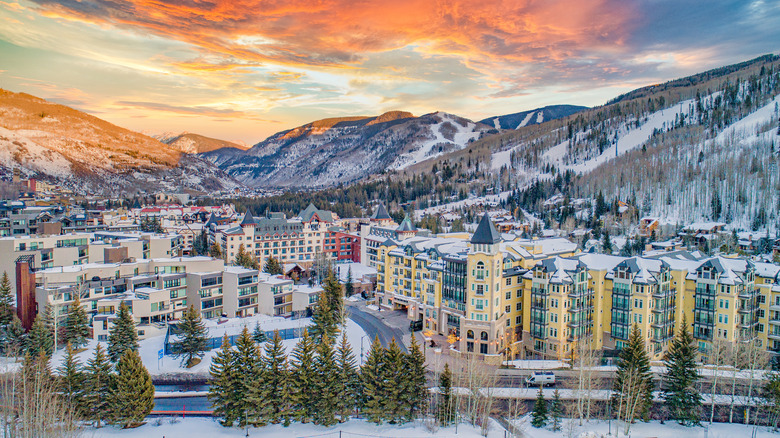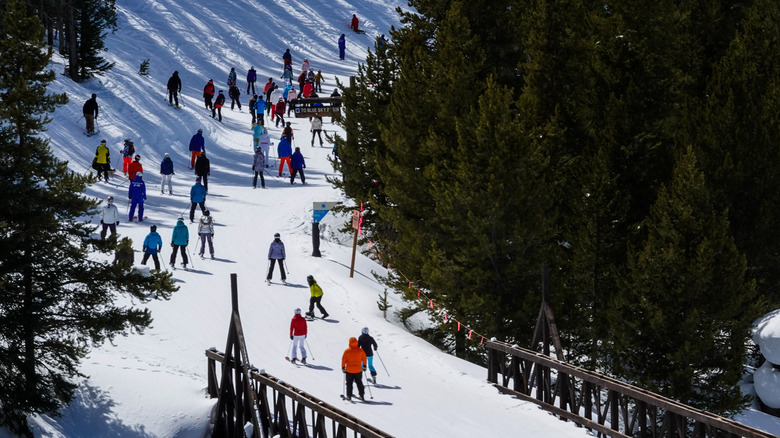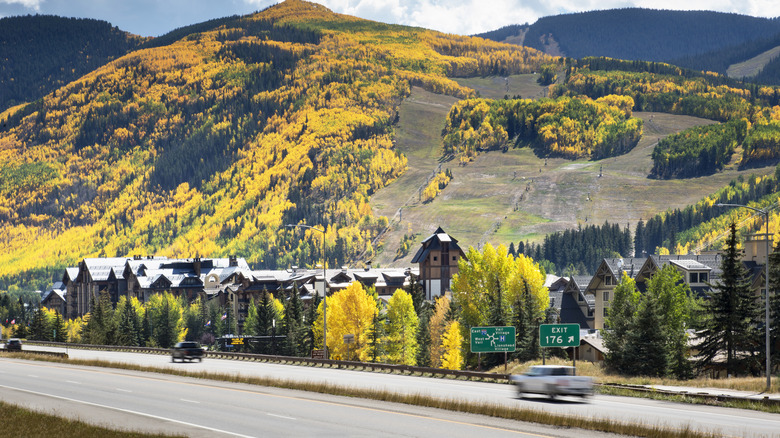Colorado Locals Love To Hate The Iconic Resort Town Of Vail. Here's Why
When you want access to America's best and most iconic beaches, you head to Florida. If you want to increase your chances of bumping into a Kardashian (or at least a lookalike), make Los Angeles' celebrity hotspots your stomping grounds. And when you wish to channel your inner Carrie Bradshaw, New York City is the place to be. But when it comes to skiing, few spots in the U.S. are more synonymous with the sport than Vail, Colorado. With plenty of ski resorts, including the renowned Vail Ski Resort — the largest ski mountain in the state — it attracts nearly four million visitors annually, most eager to carve up the slopes. Then again, as more tourists flock to Vail, the locals who call it home are increasingly disillusioned. What was once a quaint mountain town has become overrun, overpriced, and overcrowded, leaving many residents feeling alienated in their own community.
But believe it or not, Vail wasn't always this way. In fact, it's practically a baby in town years, having only been officially incorporated in 1966. Before that, it was nothing but a sheep pasture, until two war veterans, Peter Seibert and Earl Eaton, decided to turn it into a skier's paradise. With the backing of investors, they transformed Vail into one of the most famous resort towns in the world, building ski lifts, restaurants, hotels, and more. On paper, it sounds like a dream destination for snow lovers — and for tourists, it certainly is. But for the locals? Not so much.
Locals can no longer afford housing in Vail
Vail might thrive on its skiing industry, but the people keeping it afloat are finding it harder to justify sticking around. Sure, tourism is booming, but for locals trying to make ends meet, it's a different story. Take Allison Weibel, a teacher who moonlights as a ski instructor. Even with her $60,000 income, she found it nearly impossible to stay in Vail, where just the mortgage can run over $2,500 a month — more than half her monthly salary. "Teachers, like myself, want to stay here in the community, but doing so requires the stability that homeownership can offer," she told Business Insider. "It's a sad thing when public employees don't have that option."
Even rent can be downright ridiculous, with locals on the sub-Reddit r/Vail noting that you could be coughing up thousands for what is essentially a shoebox. "Expect to pay thousands for a closet running price is almost 2.7k for a bedroom," one user vented. And the cost of food? Since the entire town is basically a resort, you're shelling out resort prices for, well, everything. "There's no real town. The 'town' is basically vail village," another user lamented. "Town of vail is the worst as far as everyday living."
And then there's overcrowding. Vail might be built to welcome tourists, but it's doing so at the expense of the people who live and work there. Resorts are selling ski passes like there's no tomorrow, but with not nearly enough staff to handle the avalanche of eager skiers. "They left local resorts ill-equipped to deal with that burden," a ski instructor told Outside.
Not all hope is lost — the future is still bright for Vail
Fixing Vail's mounting problems won't happen overnight, but there are glimmers of hope. In October 2024, The Colorado Sun reported that Vail Resorts and the Town of Vail teamed up to address the town's housing crisis by shifting plans from luxury condos to affordable workforce housing — an actual step in the right direction. "Vail has always been a community and mountain that embraces innovation, and this new fourth base village marks the next chapter in innovative partnerships that will ensure Vail stays the leading resort community in North America, and one of the best mountain towns anywhere," Chris Frampton, the chief executive of East West Partners, the project's developer said in a statement.
On the tourism front, the Colorado Tourism Office (CTO) launched its 10-year initiative, the Colorado Destination Stewardship Strategic Planning Initiative in September 2024, which is aimed at balancing record-high visitation with the need to protect the local environment and residents' quality of life. The plan includes sustainability and stewardship projects, input from local communities, and strategies like timed-entry systems at busy spots. "This plan is a roadmap for the future of Colorado tourism, shaped by the collective vision of our industry and communities to position tourism as a force for good," noted Timothy Wolfe, Director of the CTO. "We are grateful to our partners and look forward to implementing these strategies, ensuring visitors and residents continue to Do Colorado Right." While the road ahead is long, at least it seems Vail — and Colorado at large — is finally getting serious about truly addressing the balance between its tourist draw and the needs of those who live there.


